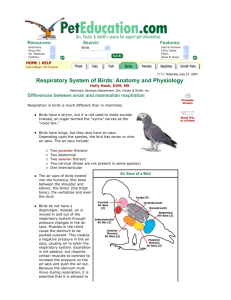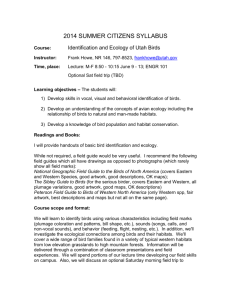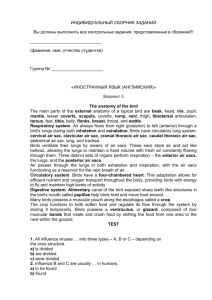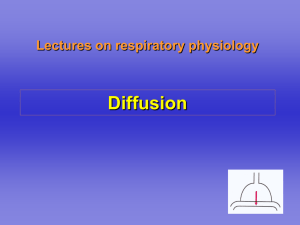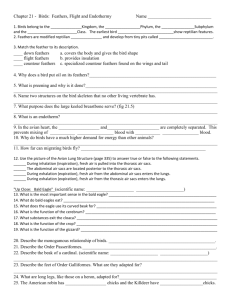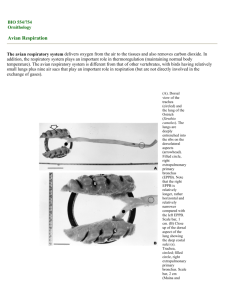Bird Respiration: Lessons in Efficiency
advertisement
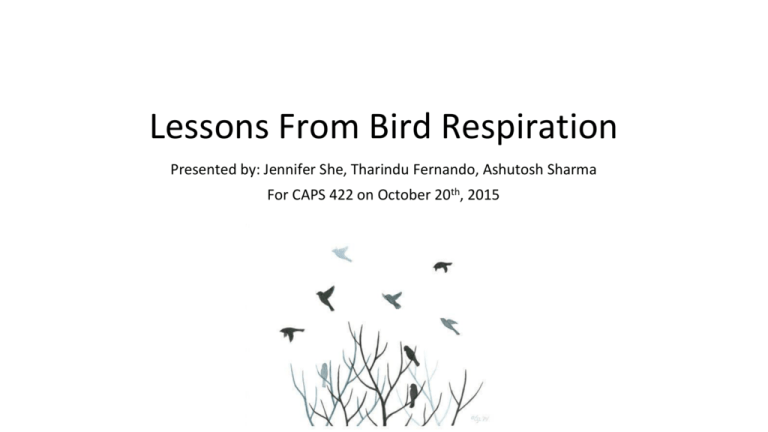
Lessons From Bird Respiration Presented by: Jennifer She, Tharindu Fernando, Ashutosh Sharma For CAPS 422 on October 20th, 2015 What lessons can we learn from bird respiration? • Why do birds need to be more efficient? • What does avian respiratory anatomy look like? • How does air circulate in the avian respiratory system? • How is gas exchange more efficient in birds? • How is diffusion made more efficient in birds? The struggles of a bird… ● Birds use up much more energy than we do ○ Basal metabolic rate of a young 70 kg white man: ~25 kcal/kg/day ○ For a swan: ~47 kcal/kg/day ○ For a hummingbird: >1500 kcal/kg/day ● Oxygen (PO2) is also limited at high altitudes* A special species of murderous birds. Because of this, birds would do well to have highly efficient respiratory systems to compensate. *In this presentation, we will focus primarily on adaptations in the bird respiratory system that occur at high altitudes. Bird vs. Human – Anatomy Bird vs. Human – Anatomy Bird Anatomy - Air Sacs Anterior Sacs Posterior Sacs Bird Anatomy - Parabronchi • No alveoli • Parabronchi with atria that project radially Inspiration During inspiration: sternum moves forward and downward; ribs move cranially expands the both posterior and anterior air sacs -> lowers the pressure! air from the bronchi flows into the posterior air sacs air from the lungs moves into the anterior air sacs this happens simultaneously! Expiration During expiration: sternum moves backwards and downward; ribs move caudally contracts both posterior and anterior air sacs -> increasing the pressure! air from the posterior sacs flows into the lungs air from the anterior air sacs moves out the trachea this happens simultaneously! Unidirectional Flow (Kuss, 2012) Uniform Pool Model in Humans • Air simply pools in the alveoli • Capillary in contact with same pool of air • Blood and air oxygen can only equilibrate • Arterial blood oxygen is at most only equal to air oxygen levels (Scott. G. R., 2011) Higher blood O2 Low blood O2 Cross-Current Exchange in Birds Low air O2 High air O2 • Blood capillaries are positioned perpendicular to air capillaries • Constant diffusion of air into capillaries Higher blood O2 Low blood O2 • Blood pools from multiple capillaries into 1 final endpoint • PaO2 > PEO2 (Scott. G. R., 2011) Principles of Diffusion Avian haemoglobin has a difference in the alpha-A subunit • Increases affinity for Oxygen • Allows birds to make better use of the low Oxygen at higher altitudes (Scott, 2011) Difference shown in green (Pro to Ala) Principles of Diffusion Rate of gas exchange proportional to A Fick’s Law of Diffusion: • Birds have larger surface area of capillaries • More Oxygen transferred per unit time compared to mammals (Maina et al., 2010) Principles of Diffusion Rate of gas exchange proportional to 1/T Fick’s Law of Diffusion: • Thickness of blood-gas barrier is smaller than in mammals • Thinnest among all terrestrial vertebrates • Quicker diffusion of oxygen across capillaries (Maina et al., 2010) Principles of Diffusion On a more microscopic level… mitochondria Fick’s Law of Diffusion: - In active muscle fibres of some birds (e.g. bar-headed geese), mitochondria are located closer to capillaries - This decreases the intracellular distance that O2 must travel by diffusion (Scott et al., 2009) Key Points • Unidirectional flow → no mixing • Hemoglobin has higher affinity for Oxygen • More surface area + thin blood-gas barrier + small distance to mitochondria (Fick’s principle) • Cross-current exchange - What can we learn from bird respiration? - All of the above increase efficiency! That’s all, folks! Thanks for listening :) References Kuss, B. (2012). A Comparative Look at Vertebrate Lungs: Bird Respiratory System. Comparative Anatomy: The Respiratory System. Retrieved October 12, 2015 from:http://inside.ucumberlands.edu/academics/biology/faculty/kuss//courses/Respiratory%20system/LungsOfTetrapods.htm. Maina, J., West, J., Orgeig, S., Foot, N., Daniels, C., Kiama, S., Gehr, P., Mühlfeld, C., Blank, F., Müller, L., Lehmann, A., Brandenberger, C. and Rothen‐Rutishauser, B. (2010). Recent Advances into Understanding Some Aspects of the Structure and Function of Mammalian and Avian Lungs. Physiol Biochem Zool, 83(5), pp.792-807. Maina, J. (2008). Functional morphology of the avian respiratory system, the lung-air sac system: efficiency built on complexity. TOST, 79(2), pp.117-132. Ritchison, G. (2014). "Bird Respiratory System." Bird Respiratory System. Retrieved October 13, 2015 from http://people.eku.edu/ritchisong/birdrespiration.html. Scott, G. R., Egginton, S., Richards, J. G. and Milsom, W. K. (2009). Evolution of muscle phenotype for extreme high altitude flight in the bar-headed goose. Proc. R. Soc. Lond. 276, 3645-3653. Scott. G. R. (2011). Elevated performance: the unique physiology of birds that fly at high altitudes. J. Exp. Biol. 214, 2455-2462. West, J. (2009). Comparative physiology of the pulmonary blood-gas barrier: the unique avian solution. AJP: Regulatory, Integrative and Comparative Physiology, 297(6), pp.R1625-R1634. West, J., Watson, R. and Fu, Z. (2006). The honeycomb-like structure of the bird lung allows a uniquely thin blood-gas barrier. Respiratory Physiology & Neurobiology, 152(1), pp.115-118.
